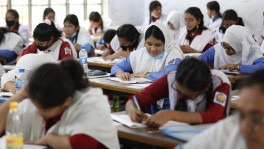Why India faces a public funding crisis
The Centre has no money for a stimulus package. Only the states can find a way to get India out of the slowdown

On 1 February, finance minister Nirmala Sitharaman will present an important Union budget. The Central Statistics Office (CSO) has projected a nominal gross domestic product (GDP) growth of 7.5% in FY20, the lowest since FY09, the year in which growth had slowed due to the global financial crisis. Naturally, the expectation is that the budget will give the economy a fiscal stimulus, either through cuts in the personal income-tax rates or by substantially increasing government expenditure.
However, these hopes are seriously misplaced. Even in the absence of an ongoing economic slowdown, barely 20% of the central government's total revenue receipts—from both tax and non-tax sources—are available in a given year for funding discretionary expenditure.
That is, all the money that is spent on central schemes and centrally-sponsored schemes, the non-establishment portion of the expenditure on defence and internal security, as well as the other big-ticket items in the budget such as spending on infrastructure comes out of a narrow 20% sliver of the total money that the government raises each year.
By extension, funding committed expenditure—the expenditure on establishment (such as salaries and pensions), compensation to states for slower-than-guaranteed growth in goods and services tax revenues, interest payments on past borrowings, and all statutory and finance commission transfers to states—takes up 80% of the government of India's total revenue receipts.
All other expenditure is financed by borrowing. Most borrowing is used to finance current expenditure, rather than capital expenditure. Last year, for example, almost 70% of borrowing was for current expenditure.
With revenue growth sluggish in a slowdown, the already-tight fiscal space has shrunk even further. In such a situation, windfall receipts from the Reserve Bank of India (RBI) or the telecom sector can help, but will not resolve the precipitous drop in the central government's revenue receipts, which has only been exacerbated, potentially, by the corporate tax cuts that were announced in September and, certainly, by the growth slowdown.
Besides, even if disinvestment sales go through as budgeted (which is highly unlikely), the reprieve will last just for a year. The crunch will recur in FY21. Calculations based on budget figures show that just maintaining total expenditure in FY21 at the same levels as budgeted in FY20 will push the fiscal deficit up to 4.57% of GDP.
Therefore, it is no exaggeration to say that the government has a serious public funding crisis at hand.
Heroic assumptions
The fiscal constraints on the government, driven by the need to borrow for current (revenue) spending, and sluggish tax revenues are an endemic, long-term problem.
The 5 July 2019 budget had made some heroic assumptions. First, the government assumed that the nominal growth rate in FY20 will be 12%. Second, it assumed that the net tax-GDP ratio will increase from 6.93% in FY19 to 7.8% (implying a marked improvement in tax collection).
How much additional fiscal space do these optimistic assumptions yield? With these assumptions, the committed expenditure falls to 73% of total expenditure (compared to the usual trend of 80%), opening up an additional fiscal space equal to 7% of total expenditure for increasing spending on development, defence and internal security.
Now, let's see what fiscal space is actually available to the government for stimulating the economy, with the nominal growth rate in FY20 slowing to 7.5% of GDP (instead of the projected 12%), as predicted by CSO.
The most benign possibility is that the target for revenue receipts (or exchequer earnings) at 9.28% of GDP is attained, but for a lower GDP despite the growth slowdown (implying a greater tax buoyancy, or, simply put, tax collections grow at a pace faster than even the rate of growth of GDP). Other things remaining the same, the fiscal deficit would then rise to 3.86% of GDP (Chart 1). Committed expenditures would be roughly 75% of revenue receipts.
But given the cuts in corporate tax, it would be reasonable to assume that the revenue-GDP ratio would be no higher in FY20 than in FY19. Committed expenditure is now back to 85% of revenue receipts (Chart 1, column 3). The fiscal deficit would rise further by a whopping 1.4% of GDP even if disinvestment receipts were exactly on target and if the total expenditure was maintained at the same levels as budgeted in FY 20.

Fiscal deficit worries
If this does not signal a serious fiscal situation, then what does? But this is all just about FY20. What happens in FY21, the year after growth slows to a multi-year low? In scenario 1B (Chart 1), a generous rise in the nominal GDP growth rate to 10% is assumed. That is, the country snaps out of the slowdown to return to a modest growth path. A positive buoyancy in revenue receipts is also assumed. Even then, the fiscal deficit remains in the 4.5%-plus range (without including off-budgetary spending).
It is clear that the slowdown has exacerbated an already grim fiscal situation in which if the central government wants to spend anything more than its current expenditure, the on-budget fiscal deficit will be 4.5% of GDP, even if nominal growth returns to double digits and revenue performance improves.
In the above analysis, expenditure GDP ratios have been maintained as budgeted. But if expenditure cuts are executed in FY20, then that would have an adverse impact on economic recovery.
If disinvestment receipts fall, and if there is further off-budget borrowing, the fiscal situation will be even grimmer. Windfall receipts from the telecom sector, RBI, etc. would help the situation but not address the central problem, which is a precipitous drop in revenue receipts, exacerbated, potentially, by tax cuts.
So, why is there so little room for capital expenditure? Because the central government borrows heavily to fund revenue expenditure, which is the expenditure incurred on the day-to-day functioning of the government and on various services offered to citizens. This is perhaps the most stable long-term trend in the central government's public finances, as chart 2 shows.
Arguments for increased counter-cyclical spending do not take account of this reality. To expect significant countercyclical spending by the central government is wishful thinking, given the heavy burden of its committed expenditures.
The way forward
What is the way out then? Taken collectively, states are a much better bet to nudge the country towards an economic recovery than pinning all hopes on the central government.
It is often forgotten that fiscal policy in India is conducted at two levels. However, the focus tends to be on the Centre, ignoring the fact that the states collectively are now larger fiscal participants than the government of India. In FY19, for example, the total expenditure of the states and the Centre was 28.66% of GDP. Of this, 16.5% was states' spending, compared to 12.16% by the central government.
Taken collectively, states also borrow largely for capital expenditure and this trend has in fact been improving over time, in clear contrast to the central government picture (Chart 2).
Almost the entire fiscal deficit incurred by the states is utilized for capital expenditure. The Centre utilizes only 30% of its fiscal deficit for capital expenditure.
In addition, revenue receipts of the states (as a whole) are 60% higher than those of the centre in FY19 (Chart 3). In fact, states' own tax revenue was higher than the net tax revenue of the Centre in that year. Committed expenditure accounts for a far lower fraction of revenue receipts. Finally, farm loan waiver and income support schemes have also not significantly stressed the fiscal position of the states.
Of course, this is true of states taken collectively. There are individual states that are fiscally stressed. Even so, ultimately, if fiscal space is to be found to counter the slowdown through public expenditure, it is to be found at the level of the states.
Transfers and other public expenditure stimuli such as public works would involve substantial increases in revenue expenditure for which fiscal space is clearly available to the states due to the lower committed expenditure burden. There is also space to protect health and education expenditures at the sub-national level, which is the level at which these expenditures are incurred.
The fiscal position of India, if we include all levels of government, continues to be healthy. However, it should be clear from the analysis that there is a significant difference between the health of the Centre and that of the states. The Centre is severely fiscally constrained with low growth rates only accentuating the problem, as its revenue performance has worsened, and other revenue and capital receipts continue to be sluggish. States, on the other hand, have fiscal space to counter the slowdown.
From a macro-fiscal perspective, a general government view of the fiscal situation gives a bit more clarity about where fiscal space can be located to counter the slowdown. This would, of course, involve coordinated work by the Centre and state governments, which would, in turn, require both levels to rise above competitive politics in the national interest.
Rathin Roy, is director of National Institute of Public Finance and Policy, and a former member of the Prime Minister's Economic Advisory Council. Puja Mehra is a Delhi-based journalist.


 Keep updated, follow The Business Standard's Google news channel
Keep updated, follow The Business Standard's Google news channel
















